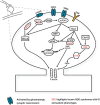Investigating mechanisms underlying neurodevelopmental phenotypes of autistic and intellectual disability disorders: a perspective
- PMID: 24198768
- PMCID: PMC3814085
- DOI: 10.3389/fnsys.2013.00075
Investigating mechanisms underlying neurodevelopmental phenotypes of autistic and intellectual disability disorders: a perspective
Abstract
Brain function and behavior undergo significant plasticity and refinement, particularly during specific critical and sensitive periods. In autistic and intellectual disability (ID) neurodevelopmental disorders (NDDs) and their corresponding genetic mouse models, impairments in many neuronal and behavioral phenotypes are temporally regulated and in some cases, transient. However, the links between neurobiological mechanisms governing typically normal brain and behavioral development (referred to also as "neurotypical" development) and timing of NDD impairments are not fully investigated. This perspective highlights temporal patterns of synaptic and neuronal impairment, with a restricted focus on autism and ID types of NDDs. Given the varying known genetic and environmental causes for NDDs, this perspective proposes two strategies for investigation: (1) a focus on neurobiological mechanisms underlying known critical periods in the (typically) normal-developing brain; (2) investigation of spatio-temporal expression profiles of genes implicated in monogenic syndromes throughout affected brain regions. This approach may help explain why many NDDs with differing genetic causes can result in overlapping phenotypes at similar developmental stages and better predict vulnerable periods within these disorders, with implications for both therapeutic rescue and ultimately, prevention.
Keywords: critical periods; development; gene expression; neurodevelopmental disorders; phenotype.
Figures



Similar articles
-
Sensitive and critical periods during neurotypical and aberrant neurodevelopment: a framework for neurodevelopmental disorders.Neurosci Biobehav Rev. 2015 Mar;50:180-8. doi: 10.1016/j.neubiorev.2014.12.001. Epub 2014 Dec 10. Neurosci Biobehav Rev. 2015. PMID: 25496903 Review.
-
Sensitive time-windows for susceptibility in neurodevelopmental disorders.Trends Neurosci. 2012 Jun;35(6):335-44. doi: 10.1016/j.tins.2012.03.005. Epub 2012 Apr 26. Trends Neurosci. 2012. PMID: 22542246
-
Dissecting the genetic basis of comorbid epilepsy phenotypes in neurodevelopmental disorders.Genome Med. 2019 Oct 25;11(1):65. doi: 10.1186/s13073-019-0678-y. Genome Med. 2019. PMID: 31653223 Free PMC article.
-
Annual research review: The (epi)genetics of neurodevelopmental disorders in the era of whole-genome sequencing--unveiling the dark matter.J Child Psychol Psychiatry. 2015 Mar;56(3):278-95. doi: 10.1111/jcpp.12392. Epub 2015 Feb 11. J Child Psychol Psychiatry. 2015. PMID: 25677560 Review.
-
Reflections on the genetics-first approach to advancements in molecular genetic and neurobiological research on neurodevelopmental disorders.J Neurodev Disord. 2021 Jun 21;13(1):24. doi: 10.1186/s11689-021-09371-4. J Neurodev Disord. 2021. PMID: 34148555 Free PMC article. Review.
Cited by
-
Presymptomatic training mitigates functional deficits in a mouse model of Rett syndrome.Nature. 2021 Apr;592(7855):596-600. doi: 10.1038/s41586-021-03369-7. Epub 2021 Mar 24. Nature. 2021. PMID: 33762729 Free PMC article.
-
Environmental Mechanisms of Neurodevelopmental Toxicity.Curr Environ Health Rep. 2018 Mar;5(1):145-157. doi: 10.1007/s40572-018-0185-0. Curr Environ Health Rep. 2018. PMID: 29536388 Free PMC article. Review.
-
Neurodevelopmental Perspectives on Wnt Signaling in Psychiatry.Mol Neuropsychiatry. 2017 Feb;2(4):219-246. doi: 10.1159/000453266. Epub 2017 Jan 13. Mol Neuropsychiatry. 2017. PMID: 28277568 Free PMC article. Review.
-
SYNGAP1: Mind the Gap.Front Cell Neurosci. 2016 Feb 15;10:32. doi: 10.3389/fncel.2016.00032. eCollection 2016. Front Cell Neurosci. 2016. PMID: 26912996 Free PMC article. Review.
-
Co-regulation of mRNA translation by TDP-43 and Fragile X Syndrome protein FMRP.Acta Neuropathol. 2016 Nov;132(5):721-738. doi: 10.1007/s00401-016-1603-8. Epub 2016 Aug 12. Acta Neuropathol. 2016. PMID: 27518042 Free PMC article.
References
-
- Anderson G. R., Galfin T., Xu W., Aoto J., Malenka R. C., Sudhof T. C. (2012). Candidate autism gene screen identifies critical role for cell-adhesion molecule CASPR2 in dendritic arborization and spine development. Proc. Natl. Acad. Sci. U S A 109, 18120–18125 10.1073/pnas.1216398109 - DOI - PMC - PubMed
LinkOut - more resources
Full Text Sources
Other Literature Sources

